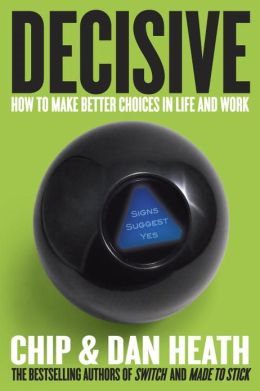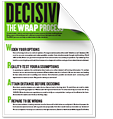Great decision making is the key to your business success.
Decision making is critical in your business. Recall the following blogs Execution or Bad Choices – Why Do Businesses Fail and Decision Making – Strategies Impact American management guru and consultant, Peter Drucker noted that businesses don’t fail due to poor execution but rather from poor decision making. We’ve explored the perils of indecisive leadership in Business & Leadership Failure: Indecisiveness (#2-29-13) Newsletter #138.
We’ve pursued the four factors that make business decisions difficult and addressed Four Villains of Decision Making.
Pursuing better decisions, the Heath Brothers in Decision Making: Decisive: How to Make Better Choices in Life and Work  provide a mnemonic WRAP, which captures four verbs to help in making better decisions. The Heaths recommend and explain what they characterize as the WRAP process:
provide a mnemonic WRAP, which captures four verbs to help in making better decisions. The Heaths recommend and explain what they characterize as the WRAP process:
- Widen Your Opinions,
- Reality-Test Your Assumptions,
- Attain Distance Before Deciding, and
- Prepare to Be Wrong.
Their reason for writing the book, “We want to make you a bit better at making good decisions, and we want to help you make good decisions a bit more decisively (with appropriate confidence, as opposed to overconfidence). We also want to make you a better adviser to your colleagues and loved ones who are making decisions, because it’s usually easier to see other people’s biases than your own.”
Heath Brothers have a website with a number of resources for this and their previous books. Some of tools on the website include The Wrap Process 1-page summary of the WRAP model, the First Chapter of the book, A Decisive Workbook, several audio files with interviews, and 12 decision situations to work on your ability to use the WRAP formula. You’ll need to supply your email address to login to download these.
Here’s how the Heather Brothers describe the WRAP formula. The four steps in the WRAP model are sequential; in general, you can follow them in order—but not rigidly so. Sometimes you’ll double back based on something you’ve learned. For example, in the course of gathering information to Reality-Test Your Assumptions, you might discover a new option you hadn’t considered before. Other times, you won’t need all of the steps. A long-awaited promotion probably won’t require much distance before you accept and pop the champagne. At its core, the WRAP model urges you to switch from “auto spotlight” to manual spotlight. Rather than make choices based on what naturally comes to your attention—visceral emotions, self-serving information, overconfident predictions, and so on—you deliberately illuminate more strategic spots. You sweep your light over a broader landscape and point it into hidden corners
We can’t deactivate our biases, but these people show us that we can counteract them with the right discipline. The nature of each of the four villains of decision making suggests a strategy for defeating it:
1. You encounter a choice. But narrow framing makes you miss options. So … → Widen Your Options. How can you expand your set of choices? In the book they study the habits of people who are expert at uncovering new options, including a college-selection adviser, some executives whose businesses survived (and even thrived) during global recessions (Intel’s Andy Grove), and a boutique firm that has named some of the world’s top brands, including BlackBerry and Pentium. 
2. You analyze your options. But the confirmation bias leads you to gather self-serving info. So … → Reality-Test Your Assumptions. How can you get outside your head and collect information that you can trust? In the book you’ll learn how to ask craftier questions, how to turn a contentious meeting into a productive one in 30 seconds, and what kind of expert advice should make you suspicious.
3. You make a choice. But short-term emotion will often tempt you to make the wrong one. So … → Attain Distance Before Deciding. How can you overcome short-term emotion and conflicted feelings to make the best choice? In the book you’ll discover how to triumph over manipulative car salesmen, why losing $50 is more painful than gaining $50 is pleasurable, and what simple question often makes agonizing decisions perfectly easy. A recent article by Influence at Work on Dr. Robert Cialdini How to Move Forward by Stepping Back provides further proof for the value of getting distance in your decision making.
4. Then you live with it. But you’ll often be overconfident about how the future will unfold. So … → Prepare to Be Wrong. How can we plan for an uncertain future so that we give our decisions the best chance to succeed? In the book they show you how one woman scored a raise by mentally simulating the negotiation in advance, how you can rein in your spouse’s crazy business idea, and why it can be smart to warn new employees about how lousy their jobs will.
Do you find these ideas helpful? Possibly one of the reasons we make poor decisions is we don’t take the time, or don’t believe we have the time to make a decision. We shoot from the hip too often. We’re so busy caught up in the Whirlwind of our day job that we put decisions off until they are made for us.
If decision making is the key to your business success, then you must realize that you need time for effective decision making. This is where Execution and Strategic Discipline exert the resources and methods to help you effectively have time to make good decisions.
Is your business growing? Are you concerned about how fast you can continue to grow and finance your growth internally? Harvard Business Review provided an article How Fast Can Your Company Afford to Grow? and formula to help businesses determine how fast they could grow. Recently I hired someone to build this into an Excel spreadsheet so that my clients might gain insight into using this formula. If you’re a business that is growing and concerned whether you can keep up with just the internal pace of your cashflow be sure to read my next blog. I’ll be offering five readers the opportunity to utilize this tool for free to get your feedback.






.jpeg?width=150&height=135&name=Hand%20with%20marker%20writing%20the%20question%20Whats%20Next_%20(1).jpeg)

